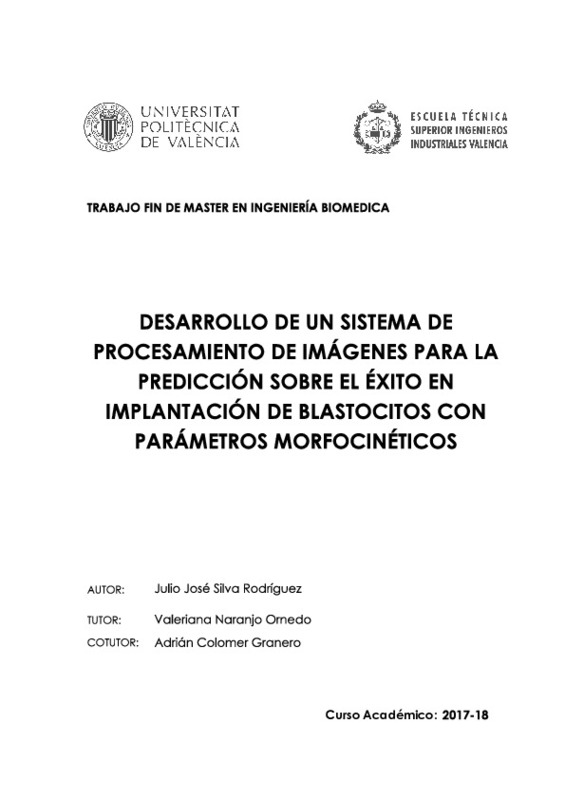JavaScript is disabled for your browser. Some features of this site may not work without it.
Buscar en RiuNet
Listar
Mi cuenta
Estadísticas
Ayuda RiuNet
Admin. UPV
DESARROLLO DE UN SISTEMA DE PROCESAMIENTO DE IMAGENES PARA LA PREDICCION SOBRE EL EXITO EN IMPLANTACION DE BLASTOCITOS CON PARAMETROS MORFOCINETICOS
Mostrar el registro sencillo del ítem
Ficheros en el ítem
| dc.contributor.advisor | Naranjo Ornedo, Valeriana
|
es_ES |
| dc.contributor.advisor | Colomer Granero, Adrián
|
es_ES |
| dc.contributor.advisor | Meseguer Escrivá, Marcos
|
es_ES |
| dc.contributor.author | Silva Rodríguez, Julio José
|
es_ES |
| dc.date.accessioned | 2018-10-10T13:45:26Z | |
| dc.date.available | 2018-10-10T13:45:26Z | |
| dc.date.created | 2018-09-25 | |
| dc.date.issued | 2018-10-10 | es_ES |
| dc.identifier.uri | http://hdl.handle.net/10251/110084 | |
| dc.description.abstract | [ES] Los procesos de Fertilización in Vitro (IVF) tratan actualmente con el desafío de la selección de embriones que aporten una mayor probabilidad de nacimiento exitoso. En el marco de este problema, se ha desarrollado un sistema de procesamiento de imágenes del crecimiento de embriones el cual extrae parámetros morfocinécticos relacionados con las etapas de división celular. Asímismo, se ha desarrollado un modelo mediante machine learning para predecir si el embrión dará lugar a un nacimiento exitoso o a una mala implantación. Se han utilizado un total de 263 videos cedidos por el Instituto Valenciano de Infertilidad (IVI), de los cuales se conocía si habían llevado a un nacimiento exitoso o a una implantación embrionaria fallida. Los parámetros se han obtenido combinando dos técnicas: la estimación de la cantidad de movimiento en cada imagen del video (SAD) y un modelo de predicción del número de células, hasta 5, en cada instante temporal. Para la segunda técnica se han seguido distintos enfoques. Primero, evaluando la textura y elementos morfológicos del embrión mediante Local Binary Pattern (LBP) y Granulometría respectivamente, combinado con técnicas de machine learning para la clasificación. Segundo, mediante el uso de deep learning con Redes Neuronales Convolucionales (CNN). Con este segundo enfoque, añadiendo un postprocesamiento basado en Campos Condicionales Aleatorios (CRF) se ha conseguido una precisión media del 85% en la detección del número de células en el embrión. A continuación, con los parámetros morfocinéticos se ha tratado de predecir el éxito en el nacimiento del embrión o la no implantación, obteniendo un 60% de precisión en el conjunto de test. Se han estudiado las limitaciones de estos parámetros y propuesto líneas de trabajo futuro para mejorar el modelo. | es_ES |
| dc.description.abstract | [EN] The processes of In Vitro Fertilization (IVF) currently deal with the challenge of selecting embryos that provide a higher probability of successful birth. Within the framework of this problem, an image processing system for embryo growth has been developed, which obtain morphological parameters related to the stages of cell division. Likewise, a model has been developed by machine learning to predict whether the embryo will lead to a successful birth or a bad implantation. A total of 263 videos donated by the Valencian Institute of Infertility (IVI) have been used, of which it was known whether they had led to a successful birth or a failed embryo implantation. The parameters have been obtained by combining two techniques: the estimation of the amount of movement in each video image (SAD) and by means of a prediction model of the number of cells, up to 5, at each instant. For the second technique, different approaches have been followed. First, evaluating the texture and elements of the embryo through Local Binary Pattern (LBP) and Granulometry, combined with machine learning techniques. Second, by using deep learning with Neuronal Convolutional Networks (CNN). With this second approach, adding postprocessing based on Random Conditional Fields (CRF), an average accuracy of 85 % has been achieved in the detection of the number of cells in the embryo. Then, with the morphokinetic parameters, it has been tried to predict the success in the birth of the embryo or the non implantation, obtaining a 60 % accuracy in the set of tests. We studied the limitations of these parameters and proposed future work to improve the model. | es_ES |
| dc.language | Español | es_ES |
| dc.publisher | Universitat Politècnica de València | es_ES |
| dc.rights | Reserva de todos los derechos | es_ES |
| dc.subject | Fecundación In Vitro | es_ES |
| dc.subject | parámetros morfocinéticos | es_ES |
| dc.subject | nacimiento exitoso | es_ES |
| dc.subject | implantación | es_ES |
| dc.subject | sistema de procesamiento de imágenes | es_ES |
| dc.subject | machine learning | es_ES |
| dc.subject | deep learning. | es_ES |
| dc.subject.classification | TEORIA DE LA SEÑAL Y COMUNICACIONES | es_ES |
| dc.subject.other | Máster Universitario en Ingeniería Biomédica-Màster Universitari en Enginyeria Biomèdica | es_ES |
| dc.title | DESARROLLO DE UN SISTEMA DE PROCESAMIENTO DE IMAGENES PARA LA PREDICCION SOBRE EL EXITO EN IMPLANTACION DE BLASTOCITOS CON PARAMETROS MORFOCINETICOS | es_ES |
| dc.type | Tesis de máster | es_ES |
| dc.rights.accessRights | Abierto | es_ES |
| dc.contributor.affiliation | Universitat Politècnica de València. Departamento de Comunicaciones - Departament de Comunicacions | es_ES |
| dc.contributor.affiliation | Universitat Politècnica de València. Escuela Técnica Superior de Ingenieros Industriales - Escola Tècnica Superior d'Enginyers Industrials | es_ES |
| dc.description.bibliographicCitation | Silva Rodríguez, JJ. (2018). DESARROLLO DE UN SISTEMA DE PROCESAMIENTO DE IMAGENES PARA LA PREDICCION SOBRE EL EXITO EN IMPLANTACION DE BLASTOCITOS CON PARAMETROS MORFOCINETICOS. http://hdl.handle.net/10251/110084 | es_ES |
| dc.description.accrualMethod | TFGM | es_ES |
| dc.relation.pasarela | TFGM\90526 | es_ES |
Este ítem aparece en la(s) siguiente(s) colección(ones)
-
ETSII - Trabajos académicos [10404]
Escuela Técnica Superior de Ingenieros Industriales






